Modern drachma
The drachma (Greek: δραχμή, [ðraxˈmi]) was the official currency of modern Greece from 1832 until the launch of the euro in 2001.
| Δραχμή (Greek) | |
|---|---|
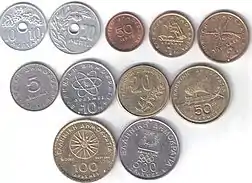 Modern drachma coins; Top row, left to right: 10λ coin, 20λ coin, 50λ coin, ₯1 coin, ₯2 coin. Middle row, left to right: ₯5 coin, ₯10 coin, ₯20 coin, ₯50 coin. Bottom row, left to right: ₯100 coin, ₯500 coin. | |
| ISO 4217 | |
| Code | GRD |
| Unit | |
| Symbol | ₯ also Δρχ. or Δρ. |
| Denominations | |
| Subunit | |
| 1⁄100 | leptοn (λ) |
| Banknotes | |
| Freq. used | ₯200, ₯1,000, ₯5,000, ₯10,000 |
| Rarely used | ₯50, ₯100, ₯500 |
| Coins | |
| Freq. used | ₯5, ₯10, ₯20, ₯50, ₯100, ₯500 |
| Rarely used | 10λ, 20λ, 50λ, ₯1 and ₯2 |
| Demographics | |
| Replaced | Phoenix |
| Replaced by | Euro |
| User(s) | None, previously: |
| Issuance | |
| Central bank | Bank of Greece |
| Website | www |
| Printer | Banknote and Securities Printing Foundation |
| Mint | Banknote and Securities Printing Foundation |
| Valuation | |
| Inflation | 3.1% (2000) |
| Source | Grecian.net |
| EU Exchange Rate Mechanism (ERM) | |
| Since | March 1998 |
| Fixed rate since | 19 June 2000 |
| Replaced by euro, non cash | 1 January 2001 |
| Replaced by euro, cash | 1 January 2002 |
| 1 € = | ₯340.75 |
| This infobox shows the latest status before this currency was rendered obsolete. | |

First modern drachma
The drachma was reintroduced in May 1832, shortly before the establishment of the Kingdom of Greece.[1] It replaced the phoenix at par. The drachma was subdivided into 100 lepta.[n 1]
Coins
The first coinage consisted of copper denominations of 1λ, 2λ, 5λ and 10λ, silver denominations of ₯1⁄4, ₯1⁄2, ₯1 and ₯5 and a gold coin of ₯20. The drachma coin weighed 4.5 g and contained 90% silver, with the ₯20 coin containing 5.8 g of gold.
In 1868, Greece joined the Latin Monetary Union and the drachma became equal in weight and value to the French franc. The new coinage issued consisted of copper coins of 1λ, 2λ, 5λ and 10λ, with the 5λ and 10λ coins bearing the names obolos (ὀβολός) and diobolon (διώβολον), respectively; silver coins of 20λ and 50λ, ₯1, ₯2 and ₯5 and gold coins of ₯5, ₯10 and ₯20. (Very small numbers of ₯50 and ₯100 coins in gold were also issued.)
In 1894, cupro-nickel 5λ, 10λ and 20λ coins were introduced. No 1λ or 2λ coin had been issued since the late 1870s. Silver coins of ₯1 and ₯2 were last issued in 1911, and no coins were issued between 1912 and 1922, during which time the Latin Monetary Union collapsed due to World War I.
Between 1926 and 1930, a new coinage was introduced for the new Hellenic Republic, consisting of cupro-nickel coins in denominations of 20λ, 50λ, ₯1, and ₯2; nickel coins of ₯5; and silver coins of ₯10 and ₯20. These were the last coins issued for the first modern drachma, none were issued for the second.
Notes

Notes were issued by the National Bank of Greece from 1841 until 1928. The Bank of Greece issued notes from 1928 until 2001, when Greece joined the Euro. Early denominations ranged from ₯10 to ₯500. Smaller denominations (₯1, ₯2, ₯3 and ₯5) were issued from 1885, with the first ₯5 notes being made by cutting ₯10 notes in half.
When Greece finally achieved its independence from the Ottoman Empire in 1828, the phoenix was introduced as the monetary unit; its use was short-lived, however, and in 1832 the phoenix was replaced by the drachma, adorned with the image of King Otto of Greece, who reigned as modern Greece's first king from 1832 to 1862. The drachma was divided into 100 lepta. In 2002 the drachma ceased to be legal tender after the euro, the monetary unit of the European Union, became Greece's sole currency.
From 1917 to 1920, the Greek government took control of issuing small change notes under Law 991/1917. During that time, the government issued denominations of 10 & 50 lepta, and ₯1, ₯2 & ₯5. The National Bank of Greece introduced ₯1,000 notes in 1901, and the Bank of Greece introduced ₯5,000 notes in 1928. The economic depression of the 1920s affected many nations around the globe, including Greece. In 1922, the Greek government issued a forced loan in order to finance their growing budget deficit. On 1 April 1922, the government decreed that half of all bank notes had to be surrendered and exchanged for 6.5% bonds. The notes were then cut in half, with the portion bearing the Greek crown standing in for the bonds while the other half was exchanged for a new issue of central bank notes at half the original value.[2] The Greek government again issued notes between 1940 and 1944, in denominations ranging from 50 lepta to 20.

During the German–Italian occupation of Greece from 1941 to 1944, catastrophic hyperinflation caused much higher denominations to be issued, culminating in ₯100,000,000,000 notes in 1944.[3] The Italian occupation authorities in the Ionian Islands printed their own currency, the Ionian drachma.
Second modern drachma
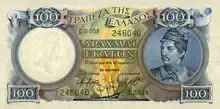
On 11 November 1944, following the liberation of Greece from Nazi Germany, old drachma were exchanged for new ones at the rate of ₯50,000,000,000 to ₯1.[4] Only paper money was issued for the second drachma. The government issued notes of ₯1, ₯5, ₯10 and ₯20, with the Bank of Greece issuing ₯50, ₯100, ₯500, ₯1,000, ₯5,000, and ₯10,000 notes. This drachma also suffered from high inflation. The government later issued ₯100, ₯500, and ₯1,000-drachma notes, and the Bank of Greece issued ₯20,000 and ₯50,000 notes.
Third modern drachma
On 9 April 1953, in an effort to halt inflation, Greece joined the Bretton Woods system. On 1 May 1954, the drachma was revalued at a rate of ₯1,000 to ₯1, and small change notes were abolished for the last time.[4] The third drachma assumed a fixed exchange rate of ₯30 per dollar until 20 October 1973: over the next 25 years, the official exchange rate gradually declined, reaching 400 drachmae per dollar.[4] On 1 January 2002, the Greek drachma was officially replaced as the circulating currency by the euro, and it has not been legal tender since 1 March 2002.
Third modern drachma coins
The first issue of coins minted in 1954 consisted of holed aluminium 5-, 10- and 20-lepton pieces, with 50-lepton, ₯1, ₯2 and ₯5 pieces in cupro-nickel. ₯10 coins of a brighter alloy were issued in 1959 and a silver ₯20 piece was issued in 1960, replacing the corresponding banknotes. Coins in denominations from 50 lepta to ₯20 carried a portrait of King Paul (1947–1964). New coins were introduced in 1966, ranging from 50 lepta to ₯10, depicting King Constantine II (1964–1974). A silver ₯30 coin for the centennial of Greece's royal dynasty was minted in 1963. The following year a non-circulating coin of this value was produced to commemorate the royal wedding. The reverse of all coins was altered in 1971 to reflect the military junta which was in power from 1967 to 1974. This design included a soldier standing in front of the flames of the rising phoenix and the date of the coup d'état, April 21, 1967.
A ₯20 coin in cupro-nickel with an image of Europa on the obverse was issued in 1973. In late 1973, several new coin types were introduced: unholed aluminium (10λ and 20λ), nickel-brass (50 lepta, ₯1, and ₯2) and cupro-nickel (₯5, ₯10, and ₯20). These provisional coins carried the design of the phoenix rising from the flame on the obverse, and used the country's new designation as the "Hellenic Republic", replacing the coins also issued in 1973 as the Kingdom of Greece with King Constantine II's portrait. A new series of all 8 denominations was introduced in 1976 carrying images of early national heroes on the smaller values.
Cupro-nickel ₯50 coins were introduced in 1980. In 1986, aluminium-bronze ₯50 coins were introduced, followed by copper ₯1 and ₯2 pieces in 1988 and aluminium-bronze coins of ₯20 and ₯100 in 1990. In 2000, a set of 6 themed ₯500 coins were issued to commemorate the 2004 Athens Olympic Games.[5]
Coins in circulation at the time of the adoption of the euro[6] were
Gallery
 Gold ₯20 coin depicting king Othon I, 1833
Gold ₯20 coin depicting king Othon I, 1833 Gold ₯20 coin depicting king Georgios I, 1876
Gold ₯20 coin depicting king Georgios I, 1876 Gold ₯50 coin depicting king Georgios I, 1876
Gold ₯50 coin depicting king Georgios I, 1876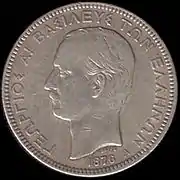 ₯5 coin, 1876
₯5 coin, 1876 ₯1 coin during the 1973–1974 military controlled Republic, 1973
₯1 coin during the 1973–1974 military controlled Republic, 1973 ₯1 coin depicting Konstantinos Kanaris, 1976
₯1 coin depicting Konstantinos Kanaris, 1976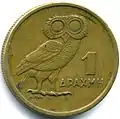 ₯1 coin depicting the Owl of Athena
₯1 coin depicting the Owl of Athena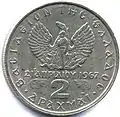 ₯2 coin with a soldier standing in front of a Phoenix
₯2 coin with a soldier standing in front of a Phoenix
Banknotes
The first issues of banknotes were in denominations of ₯10, ₯20 and ₯50, soon followed by ₯100, ₯500 and ₯1,000 by 1956. ₯5,000 notes were introduced in 1984, followed by ₯10,000 notes in 1995 and ₯200 notes in 1997.
Banknotes in circulation at the time of the adoption of the euro[7] were
- ₯100 (€0.2935), depicting Athena and Adamantios Korais
- ₯200 (€0.5869), depicting Rigas Feraios
- ₯500 (€1.47), depicting Ioannis Capodistrias
- ₯1,000 (€2.93), depicting Apollo
- ₯5,000 (€14.67), depicting Theodoros Kolokotronis
- ₯10,000 (€29.35), depicting George Papanicolaou and Asclepius
| Banknotes of the Greek drachma (circa AD 2000) | ||||||
|---|---|---|---|---|---|---|
| Image | Value | Equivalent in Euro (€) | Main Color | Obverse | Reverse | Watermark |
| ₯50 | €0.1467 | Blue | Head of Poseidon | Laskarina Bouboulina directing cannon fire at two Ottoman ships at Palamidi during the Greek War of Independence | Head of the Charioteer of Delphi | |
| ₯100 | €0.2935 | Brown and violet (obverse); Maroon, green and orange (reverse) | Head of Piraeus Athena; Christian Hansen's National and Kapodistrian University of Athens building | Adamantios Korais; Arkadi Monastery, Crete | Head of the Charioteer of Delphi | |
| ₯200 | €0.5869 | Deep orange | Rigas Feraios; Feraios singing his patriotic song at lower right | Nikolaos Gyzis's Krifo scholio ("secret school") | Bust of Philip of Macedonia | |
| ₯500 | €1.47 | Deep green | Ioannis Kapodistrias; Capodistrias's home on Corfu | Old Fortress, Corfu City | Head of the Charioteer of Delphi | |
| ₯1,000 | €2.93 | Brown | Bust of Apollon of Olympia | Myron's Discobolus; Temple of Hera, Olympia | Head of the Charioteer of Delphi | |
| ₯5,000 | €14.67 | Deep Blue or Purple and yellow-green | Theodoros Kolokotronis; Church of the Holy Apostles, Kalamata | Karytaina, Arcadia | Bust of Philip of Macedonia | |
| ₯10,000 | €29.35 | Deep purple | Georgios Papanikolaou; microscope | Asclepius | Bust of Philip of Macedonia | |
Gallery (banknotes)
 ₯5 banknote, 1912
₯5 banknote, 1912.jpg.webp) ₯5,000,000 banknote during the Axis Occupation hyperinflation period, 1944
₯5,000,000 banknote during the Axis Occupation hyperinflation period, 1944.jpg.webp) ₯20 banknote, 1955
₯20 banknote, 1955
Encoding
In Unicode, the currency symbol is U+20AF ₯ DRACHMA SIGN. There is a special Attic numeral, U+10142 𐅂 GREEK ACROPHONIC ATTIC ONE DRACHMA, for the value of one drachma but it fails to render in most browsers.[8]
Restoration
The Drachmi Greek Democratic Movement Five Stars, which was founded in 2013,[9] aims to restore the Drachma as Greece's currency.
See also
Notes and references
- Notes
- Greek: λεπτά; plural of λεπτόν, lepton.
- Minted but rarely used. Usually, prices were rounded up to the next multiple of 10 drachmae.
- Not minted but remained legal tender (not in actual use in 2002).
- References
- "The first modern drachma coins catalog". Retrieved 2013-06-22.
- "The Greek Financial Crises: Getting by with the Half-Drachmai | PMG". pmgnotes.com.
- "Banknote Index". banknoteindex.com. Retrieved 2019-02-01.
- "Chronology (1928–2003)". Bank of Greece (in Greek). Athens. Archived from the original on 15 February 2005. Retrieved 9 May 2020.
- "Drachma Coins" (PDF). Bank of Greece (in Greek). Retrieved 10 February 2023.
- "Bank of Greece - Coins in circulation". Archived from the original on 4 February 2005. Retrieved 2005-01-12.
- "History of Greek Banknotes". Greekcurrency.110mb.com. Retrieved 2013-11-17.
- fileformat.info Entry for (U+10142)
- "Political Party Drachma 5 Launched". greekreporter.com. 9 May 2013.
External links
- Overview of the modern Greek drachma from the BBC
- Historical banknotes of Greece (in English and German)
